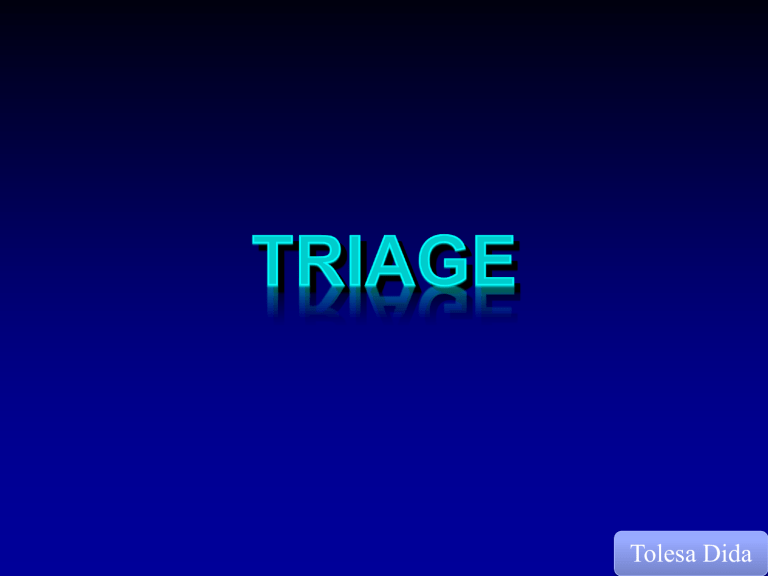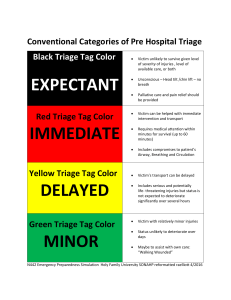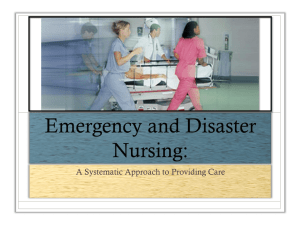
Tolesa Dida Outline Definition Triage classification 5 level triage Decision making tree Patient assessment Cases – Questions and answers Definition Triage comes from the French word “trier” Trier mean to sort into different groups or categories. Baron Dominique Jean Larré – Napoleon’s surgeon – Changed the treatment of injured soldiers » Least injured first, return to war ትርጉም ትሪያጅ ምምማይ “Sorting” - Classifying of casualties ምውዳብ/ምክፍፋል Establish priorities for treatment / evacuation - ቅዳም ሰዓብ Dynamic process ƒ]ÁÏ ”U”• • ታÃ ይጠቅም; Why Triage? ጥmGû |Q¿Ë Benefits of Triage Early assessment of the patient thus reducing any harmful delays. – This improves the standard of care given to the patient It reduces waiting times for non-urgent patients. Investigations maybe commenced prior to seeing a doctor Requests may be made for old notes, X rays, results ጥmGû |Q¿Ë Benefits of Triage The triage officer has the opportunity of seeing the interaction between family and patient Infection control may be initiated earlier Emergency care is given thus making the patient more comfortable Promote and distribute health education literature Triage Principles Regular time/disaster time Life over limb Bodily function over cosmetic appearance Greatest good for the greatest number ትሪያጅ መን እዩ ክገብሮ ዝግባእ? ትሪያጅ መን እዩ ክገብሮ ዝግባእ? Who Should be the Triage Officer? Physician Nurse Health Officer Technician Dentist Triage Factors Availability of transportation Resources Facilities Continuous process Triage Multiple casualties Single casualty with multiple injuries Triage Classification Systems START – Simple Triage and Rapid Treatment Military/International Others – Australian – Manchester – Cape Triage Color Coding Casualties are color coded to quickly identify a casualty’s priority for medical treatment. International Color Codes are: Black – Expectant/Dead-Dying Red - Immediate Yellow - Delayed Green – Minimal/Minor US Military Color Code (MEDIC) Blue - Expectant Australlian 5 level – Red – Orange – Yellow – Green – Blue/Black Australlian 5 colours Red Orange Yellow Green Blue Immediate 10 mins 60 mins 4 hours Dead TEWS: Triage Early Warning Score TEWS: Adult 3 2 1 Mobility 0 1 2 Walking With Help Stretcher/ Immobile 9-14 15-20 21-29 more than 29 101-110 111-129 more than 129 RR less than 9 HR less than 41 41-50 51-100 71–80 81-100 101-199 more than 199 35-38.4 38.5 or more SBP Temp less than 71 less than 35 AVPU Alert Reacts to Voice Trauma No Yes over 12 years / taller than 150cm Reacts to Pain 3 Unrespon sive TEWS: Child 3 2 Mobility 1 0 1 2 Walking With Help Stretcher/ Immobile RR less than 15 15-16 17-21 22-26 27 or more HR less than 60 60-79 80-99 100-129 130 or more SBP less than 70 70-79 80-130 131-149 150 or more less than35 35-38.4 Temp 3 38.5 or more AVPU Alert Reacts to Voice Trauma No Yes 3 to 12 years old / 96 to 150 cm tall Reacts to Pain Unrespon sive TEWS: Infant 3 2 Mobility 1 0 1 2 Normal for age Stretcher/ Immobile 3 RR less than 20 20-25 26-39 40-49 50 or more HR less than 70 70-79 80-130 131-159 160 or more SBP less than 60 60-69 70-110 111 or more less than 35 35-38.4 38.5 or more Temp AVPU Alert Reacts to Voice Trauma No Yes Reacts to Pain younger than 3 years / smaller than 95cm Unresponsive Steps To Follow Step 1 Measure vital signs and document the findings Step 2 Take a brief history directed at the main complaint and document this Step 3 Calculate the TEWS and document the total value Step 4 Match the score to the list and observe the discriminator list for issues not picked up by the TEWS Step 5 Document the triage code and act accordingly Example 30 year old, electrical burn – Walking – RR 24 – HR 110 – SBP 115 - Temp 37 - Alert - Trauma TEWS total = – Colour Code? ____________ Colour RED ORANGE YELLOW GREEN BLUE TEWS 7 or more 5-6 3-4 0-2 DEAD Target time to treat Immediate less than 10 mins less than 60 mins less than 240 mins Mechanism of injury Discriminators: Adult High energy transfer Shortness of breath - acute Coughing blood Chest pain • Final Triage Haemorrhage - uncontrolled Seizure – current Haemorrhage - controlled Seizure - post ictal – ORANGE Focal neurology - acute Level of consciousness reduced Psychosis / Aggression Threatened limb Dislocation - other joint Fracture - compound Presentation Dislocation - finger or toe Fracture - closed Burn over 20% ALL OTHER PATIENTS Burn - electrical Burn – face / inhalation Burn - other Burn - circumferential Burn - chemical Poisoning / Overdose Hypoglycaemia glucose less than 3 Diabetic 11 Vomiting - glucose over & ketonuria fresh blood Abdominal pain Diabetic glucose over 17 (no ketonuria) Vomiting - persistent Pregnancy & trauma Pregnancy & abdominal trauma or pain Pregnancy & Pain Severe PV bleed Moderate Senior Healthcare Professional’s Discretion Mild DEAD Minimal/Minor Green tag Minor threat to patient’s life Classic “Walking Wounded” – Easily segregated – Tend to later Self-Aid, buddy care Treat and release, – return to duty/manpower pool Minimal/Minor Minor lacerations Abrasions Sprains Contusions Burns under 20% BSA – Rule of 9’s Combat stress casualties Immediate Red tag Threat to life is great Simple procedure will be lifesaving – Reposition airway, control hemorrhaging,… Must receive urgent treatment Immediate Airway obstruction Sucking chest wounds Massive external bleeding Shock Incomplete Amputation 2nd/3rd degree burns of face or neck Delayed Injuries that are serious Delay in treatment is not life threatening Require care but no immediate life saving procedures Treatment, including surgery may be delayed several hours Delayed Open chest wounds Penetrating abdominal wound (evisceration) Severe eye injury Open wounds Non-life threatening fractures 2nd/3rd degree burns not involving the face/neck Expectant/Dead-Dying Little hope of recovery Great threat to life Treatment is complicated/time consuming Supportive vs curative treatment Only used if resources are limited Expectant/Dead-Dying Large open head wounds with loss of tissue Decapitation Massive crush injury of the chest/neck Large open chest wound Penetrating injury to trachea/neck 2nd/3rd degree burns greater then 60% BSA Multiple trauma Contaminated Not a true triage category Be alert to possibility Segregate immediately Prevent contamination of other patients, medical staff, facility Complicates management and treatment – Biological, not likely to have conventional injuries – Chemical, greater likelihood of combination conventional, chemical injuries Decontaminate prior to any treatment Patient Assessment ATLS/BTLS TREATMENT Primary Survey - ABC’s (Triage) Resuscitation Secondary Survey - Total Patient Evaluation Definitive Care Transfer PRIMARY SURVEY Airway maintenance / cervical spine control Breathing and ventilation Circulation with hemorrhage control Disability: Neurologic status Exposure/Environmental control: – undress the patient, prevent hypothermia RESUSCITATION Management of life-threatening problems identified in the primary survey Oxygenation and ventilation Shock management - IV lines, Ringer’s Monitoring SECONDARY SURVEY Head and skull Maxillofacial Neck Chest Abdomen Perineum/rectum/ vagina Musculoskeletal Complete neurologic exam Roentgenograms, lab tests “Tubes and fingers” DEFINITIVE CARE After identifying patient’s injuries After managing life-threatening problems After obtaining special studies Definitive care begins TRANSFER If the patient’s injuries exceed the immediate treatment capabilities The process of transferring the patient is initiated as soon as the need is identified Delay may significantly increase the patient’s risk of mortality Availability of airlift Triage Exercise You are working in a hospital where number of casualties brought to your Emergency Room. You are tasked to retrieve, triage, and prioritize the injuries for treatment/transport. There are six bodies with the following injuries: TRIAGE EXERCISE Bus Driver - unresponsive with a penetrating injury to the trachea region Patient One - bullet wounds to the lower legs with bright red blood spurting out Patient Two - lacerations to the face and a suspected sprain to the right foot TRIAGE EXERCISE Patient Three - conscious but somewhat confused & 3rd degree burns of the arms Patient Four - partial amputation of the right arm and signs of shock Jeep Driver - walking around the area with an open wound on his forehead What is your assessment of these 6 patients? TRIAGE EXERCISE Immediate - require life saving care but can be stabilized – Patient One - bullet wounds to the lower legs with bright red blood spurting out – Patient Four - partial amputation of the right arm and signs of shock Delayed – significant injuries required treatment, but not immediately life threatening – Patient Three - conscious but somewhat confused & 3rd degree burns of the arms TRIAGE EXERCISE Minimal – minor injuries, treatment can be delayed – Jeep Driver - walking around the area with an open wound on his forehead – Patient Two - lacerations to the face and a suspected sprain to the right foot Expectant/Dead-Dying – life threatening injuries, attempts to stabilize may jeopardize other lives – Bus Driver - unresponsive with a penetrating injury to the trachea region When a patient is triaged as expectant, what should you do with the patient? a. Transport them first so that the bystanders don’t have to see someone like this b. Move them out of sight and worry about them later c. Care for them in the same manner as you would anybody else d. Stay with them and worry about the other patients when time allows Any time you respond to a call for help, your first priority is to? a. Assure your own safety b. Do the best you can for the greatest number of casualties. c. Call medical control and ask them what you should do d. Get to the scene as fast as the ambulance will allow you to travel How often should you reassess your patient in a mass casualty situation? a. b. c. d. Every 5 minutes Every 20 minutes Whenever necessary Never, this wastes time What is the purpose of the various colors on the triage tags? a. To keep track of the number of casualties b. So that medical personnel know which casualties to treat first c. To allow the casualties to know where they stand as far as treatment goes d. To make them more interesting to look at START Triage System Allows rescuers to quickly identify victims at greatest risk for early death Gaining popularity START Triage System 60 second assessment focusing on – Ability to walk, walking wounded = minor pts – Respiratory effort – Pulses/perfusion – Mental/Neurologic status Only Treatment during Triage – Open airway, insert OPA – Stop any visible bleeding – Elevate extremities for shock START PATIENT CARE DECISION TREE Can the patient walk, talk, ….. walking wounded YES Minor Patients NO Asses Respirations START (RPM’s) TRIAGE DECISION TREE Assess Respirations >30 >10, <30 0 Immediate Assess Perfusion Position Airway Respirations Yes Immediate No Expectant START (RPM’s) TRIAGE DECISION TREE Assess Perfusion Radial Pulse Absent Can Control Bleeding Immediate Capillary Refill Over 2 Seconds Under 2 Seconds Radial Pulse Present Assess Mental Status START (RPM’s) TRIAGE DECISION TREE CAN THE PATIENT FOLLOW SIMPLE COMMANDS NO YES IMMEDIATE DELAYED Respiration's Perfusion Mental Status START Triage All Walking Wounded MINOR 0, 30 2, Radial Pulse Can Do RESPIRATIONS Yes No Over 30/min Under 30/min IMMEDIATE PERFUSION Radial Pulse Absent Control Bleeding IMMEDIATE Position Airway Capillary Refill Over 2 seconds Radial Pulse Present Under 2 seconds MENTAL STATUS Can't Follow Can Follow Simple Commands Simple Commands IMMEDIATE DELAYED Yes No IMMEDIATE DECEASED Summary No hard and fast rules for triage A simplified guide to help sort casualties Triage is a continuous process Accomplish the greatest good for the greatest number START TRIAGE EXERCISE Working on an ambulance Dispatched as a second unit to a bombing of a building As you arrive you hear shouts and screams and several (19) victims lying about After assuring your own safety, what is the first action you take to begin the Triage process START TRIAGE EXERCISE Instruct all walking wounded to get up and walk to a designated area and await treatment You now have 19 patients left to triage, – Establish a triage category for each patient – Give your rationale for their triage category. Notes – If no breathing, give triage category if respirations begin/or are still absent after airway established – If radial pulse is absent, most times you can assume that bleeding can be controlled unless an obvious mortal injury is presented #1 Compound fracture of the left femur Respirations: Under 30 Pulse (radial): Absent Mental Status: A O x 4 Immediate - Radial Pulse is absent •If bleeding can be controlled #2 Sudden onset of chest pain, no shortness of breath Respirations: Under 30 Pulse (radial): Present Mental Status: A O x 4 Delayed No abnormalities noted according to criteria #3 90% second degree burns over body Respirations: None Pulse (radial): Present Mental Status: Unconscious Immediate if respiration begins after airway est Dead/Dying if no respiration after airway est #4 Patient states she is a diabetic. Skin is moist and clammy Respirations: Under 30 Pulse (radial): Absent Mental Status: A O x 4 Immediate No radial pulse #5 Unable to move legs Respirations: Under 30 Pulse (radial): Present Mental Status: Confused Immediate Impaired mental status #6 No apparent injuries Respirations: Under 30 Pulse (radial) Present Mental Status: A O x 4 Delayed No abnormalities noted according to criteria #7 Sucking chest wound Respirations: Over 30 Pulse (radial): Present Mental Status: Unconscious Immediate Respirations over 30/minute #8 Dislocated right shoulder Respirations: Under 30 Pulse (radial) Present Mental Status: A O x 4 Delayed No abnormalities noted according to criteria #9 No visible wounds Respirations : None Pulse: (radial): Absent Mental Status: Unconscious Immediate – if respirations begin after airway est Expectant – if no respiration after airway est #10 Scalp wound with an estimated blood loss of 500 cc Respirations: Over 30 Pulse (radial): Present Mental Status: Confused Immediate Respirations over 30/minute #11 Significant head injury Respiration: Under 30 Pulse (radial): Absent Mental Status: Unconscious Immediate Radial pulse absent #12 Three month old Infant Respirations: Under 30 Pulse (radial): Present Mental Status: Unconscious Immediate Impaired mental status #13 Impaled, 1 foot piece of shrapnel in RT eye Respirations: Under 30 Pulse (radial) Present Mental Status: Awake & Oriented Delayed No abnormalities noted according to criteria #14 Female 6 mos. pregnant, broken left lower leg Respirations: Under 30 Pulse (radial) Present Mental Status: Awake & Oriented Delayed No abnormalities noted according to criteria #15 Severe difficulty breathing, chest sinks in on inspiration Respirations: Over 30 Pulse (radial) Present Mental Status: Awake & Oriented Immediate Respirations over 30/minute #16 Unable to move, no verbal response Respirations: Under 30 Pulse (radial) Present Mental Status: Awake but stares into space Immediate Impaired mental status #17 Amputated left arm, bleeding controlled Respirations: Under 30 Pulse (radial) Present Mental Status: Awake & Oriented Delayed No abnormalities noted according to criteria #18 Large head wound, brain matter showing Respiration: None Pulse (radial): Absent Mental Status: Unconscious Expectant No respirations, obvious mortal injury #19 Minor abrasions Respirations: Under 30 Pulse (radial) Present Mental Status: Awake & Oriented Delayed No abnormalities noted according to criteria ሕቶ እንተልይኩም የh«½>Á ፅoúm HXD ÁÐoO@• ና





